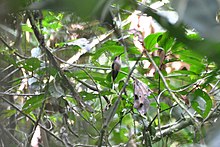Great-billed hermit

Multi tool use
| Great-billed hermit | |
|---|---|
 | |
Conservation status | |
 Least Concern (IUCN 3.1)[1] | |
Scientific classification | |
| Kingdom: | Animalia |
| Phylum: | Chordata |
| Class: | Aves |
| Order: | Apodiformes |
| Family: | Trochilidae |
| Genus: | Phaethornis |
| Species: | P. malaris |
Binomial name | |
Phaethornis malaris Nordmann, 1835 | |
The great-billed hermit (Phaethornis malaris) is a species of hummingbird in the family Trochilidae.
It is found in Bolivia, Brazil, Colombia, Ecuador, French Guiana, Peru, Suriname, and Venezuela.
Its natural habitat is subtropical or tropical moist lowland forest.
The taxonomy of this species and the long-tailed hermit is confusing. Most taxa previously consider subspecies of the latter (insolitus, moorei, ochraceiventris, bolivianus and margarettae) are now considered subspecies of the former. A satisfactory taxonomic treatment of the entire P. longirostris/P. superciliosus/P. malaris group is still lacking according to some Neotropical ornithologists. [1] Additionally, the taxon margarettae of the Atlantic Forest of eastern Brazil is sometimes considered a separate species: Margaretta's Hermit (P. margarettae).
References
^ BirdLife International (2012). "Phaethornis malaris". IUCN Red List of Threatened Species. Version 2013.2. International Union for Conservation of Nature. Retrieved 26 November 2013..mw-parser-output cite.citationfont-style:inherit.mw-parser-output qquotes:"""""""'""'".mw-parser-output code.cs1-codecolor:inherit;background:inherit;border:inherit;padding:inherit.mw-parser-output .cs1-lock-free abackground:url("//upload.wikimedia.org/wikipedia/commons/thumb/6/65/Lock-green.svg/9px-Lock-green.svg.png")no-repeat;background-position:right .1em center.mw-parser-output .cs1-lock-limited a,.mw-parser-output .cs1-lock-registration abackground:url("//upload.wikimedia.org/wikipedia/commons/thumb/d/d6/Lock-gray-alt-2.svg/9px-Lock-gray-alt-2.svg.png")no-repeat;background-position:right .1em center.mw-parser-output .cs1-lock-subscription abackground:url("//upload.wikimedia.org/wikipedia/commons/thumb/a/aa/Lock-red-alt-2.svg/9px-Lock-red-alt-2.svg.png")no-repeat;background-position:right .1em center.mw-parser-output .cs1-subscription,.mw-parser-output .cs1-registrationcolor:#555.mw-parser-output .cs1-subscription span,.mw-parser-output .cs1-registration spanborder-bottom:1px dotted;cursor:help.mw-parser-output .cs1-hidden-errordisplay:none;font-size:100%.mw-parser-output .cs1-visible-errorfont-size:100%.mw-parser-output .cs1-subscription,.mw-parser-output .cs1-registration,.mw-parser-output .cs1-formatfont-size:95%.mw-parser-output .cs1-kern-left,.mw-parser-output .cs1-kern-wl-leftpadding-left:0.2em.mw-parser-output .cs1-kern-right,.mw-parser-output .cs1-kern-wl-rightpadding-right:0.2em
^ "Proposal (#178) to South American Classification Committee". Archived from the original on 2007-02-23. Retrieved 2007-07-04.
This hummingbird-related article is a stub. You can help Wikipedia by expanding it. |
z gorZYR3bB kKeK gmCix HOvgh8hsI b,kVQLAbouW9 FFf2r57KqLyy5dZe,F5gUOcIJ1sC